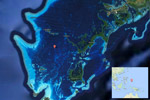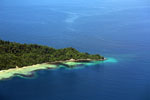It could be the plot of a horror movie: humans wake up one day to discover that chemical changes in the atmosphere are dissolving away parts of their bodies. But for small marine life known as sea butterflies, or pteropods, this is what’s happening off the West Cost of the U.S. Increased carbon in the ocean is melting away shells of sea butterflies, which are tiny marine snails that underpin much of the ocean’s food chain, including prey for pink salmon, mackerel, and herring.
“We did not expect to see pteropods being affected to this extent in our coastal region for several decades,” said William Peterson, Ph.D., an oceanographer at National Oceanic and Atmospheric Administration (NOAA)’s Northwest Fisheries Science Center who co-authored the findings in a paper for the journal, Proceedings of the Royal Society B.
Sampling sea butterflies in the species Limacina helicina off California, Washington, and Oregon in the summer of 2011, researchers found that over 50 percent of onshore sea butterflies suffered from “severe dissolution damage,” according to the paper. Offshore, 24 percent of individuals showed such damage.
 Sea butterfly in the Limacina helicina species. Photo by: Russ Hopcroft, University of Alaska, Fairbanks/NOAA. |
The shells of sea butterflies are dissolving due to increased acidification in the oceans caused by society’s CO2 emissions. While emissions from burning coal, gas, and oil are pumped into the atmosphere, the oceans eventually soak up nearly a third of the global cumulative emissions. This increase in CO2 in the oceans leads to a decrease in the availability of calcium carbonate and its crystal form, aragonite, which sea butterflies use to make their shells. Many other key species require calcium carbonate, such as corals, crustaceans, mollusks, and some plankton species.
The extent of ocean acidification varies across regions, depth, and seasons, but is particularly acute where seasonal upwellings occur. This is when deep, cold water is pushed to the surface, a phenomenon that further depletes aragonite. In fact, the worst of the impacts were seen off the coast of California, where low aragonite levels had increased sixfold in the top 100 meters of the water column.
“Limacina helicina from onshore regions showed dissolution that was evenly spread over entire surface of shells, while in offshore regions only the first whorl…showed evidence of dissolution. This suggests that less corrosive offshore conditions only affected pteropods during early stages, while prolonged exposure to more severe undersaturated conditions in onshore regions resulted in dissolution covering the whole shell,” write the scientists.
Prior to the industrial revolution—and the resultant massive influxes of CO2 from burning fossil fuels—the researchers estimated that around 20 percent of sea butterflies would have seen some shell dissolution. Today’s percentage is more than twice that—53 percent—near the coastline, and the scientists predict that 70 percent of sea butterflies will be impacted in the region by 2050.
“Acidification of our oceans may impact marine ecosystems in a way that threatens the sustainability of the marine resources we depend on,” said Libby Jewett, Director of the NOAA Ocean Acidification Program. “Research on the progression and impacts of ocean acidification is vital to understanding the consequences of our burning of fossil fuels.”
 Limacina helicina. Photo by: Russ Hopcroft, University of Alaska, Fairbanks/NOAA. |
This is not the first time scientists have found evidence of worsening ocean acidification dissolving shells of sea butterflies. Two years ago, researchers reported that they discovered sea butterflies of the same species, Limacina helicina, were losing their shells in Antarctica’s Southern Ocean.
“The snails do not necessarily die as a result of their shells dissolving, however it may increase their vulnerability to predation and infection, consequently having an impact to other parts of the food web,” lead author, Geraint Tarling of the British Antarctic Survey said in 2012.
In fact, the most recent paper notes that the shell is key to sea butterfly reproduction: “the shell is of particular importance…during the reproductive stage, when sperm are exchanged between individuals and need to be stored before fertilizing an egg.”
Since sea butterflies provide a base food source for many fish species, scientists say their decline could hurt all sorts of marine animals, including whales and seabirds.
The current acidification of the ocean is occurring at a faster rate than anytime in the last 50 million years, and the future impacts could be so catastrophic that former NOAA head, Jane Lubchenco, dubbed ocean acidification “climate change’s equally evil twin.” Yet ocean acidification still garners little media attention and global greenhouse gas emissions continue to rise.
Citations:
- Bednarsek N, Feely RA,
Reum JCP, Peterson B, Menkel J, Alin SR, Hales
B. 2014 Limacina helicina shell dissolution as
an indicator of declining habitat suitability due
to ocean acidification in the California Current
Ecosystem. Proc. R. Soc. B 20140123.
http://dx.doi.org/10.1098/rspb.2014.0123
Related articles

(03/31/2014) It’s not just melting glaciers and bizarrely-early Springs anymore; climate change is impacting every facet of human civilization from our ability to grow enough crops to our ability to get along with each other, according to a new 2,300-page report from the Intergovernmental Panel on Climate Change (IPCC). The massive report states definitively that climate change is already affecting human societies on every continent.
Corals thriving despite acidified conditions in remote Pacific bay

(02/25/2014) Scientists have discovered a small island bay in the Pacific which could serve as a peephole into the future of the ocean. Palau’s Rock Island Bay harbors a naturally occurring anomaly – its water is acidified as much as scientists expect the entire ocean to be by 2100 as a result of rising carbon dioxide emissions.

(02/24/2014) An assessment of ocean acidification, presented at the UN Climate Change Conference in Warsaw in November 2013, starkly concluded that acidity is on track to rise 170 percent by the end of this century. As many key species are sensitive to changes in acidity, this would drastically impact ocean ecosystems, with effects especially pronounced in polar regions where the cold waters intensify acidification, and which are home to many organisms that are particularly vulnerable to acidification.
Global warming could upset Antarctic food chain

(01/02/2014) Resting near the bottom of the foodchain, Antarctic krill (Euphausia superba) underpin much of the Southern Ocean’s ecosystem. But in a rapidly warming world, these hugely-abundant crustaceans could see their habitat shrink considerably. In a recent paper in PLOS ONE, scientists predict that Antarctic krill could lose 20 percent of their growth habitat, or 1.2 million square kilometers.

(10/03/2013) The oceans are more acidic now than they have been for at least 300m years, due to carbon dioxide emissions from burning fossil fuels, and a mass extinction of key species may already be almost inevitable as a result, leading marine scientists warned on Thursday. An international audit of the health of the oceans has found that overfishing and pollution are also contributing to the crisis, in a deadly combination of destructive forces that are imperiling marine life, on which billions of people depend for their nutrition and livelihood.
Bad feedback: ocean acidification to worsen global warming
(08/28/2013) As if ocean acidification and climate change weren’t troubling enough (both of which are caused by still-rising carbon emissions), new research published in Nature finds that ocean acidification will eventually exacerbate global warming, further raising the Earth’s temperature.
Google Earth presents fish-eye view of coral reefs
(08/20/2013) You can now visit up-close and personal some of the world’s most imperiled ecosystems on Google Earth: coral reefs. The Google team is working with scientists to provide 360 degree panoramas, similar to Google street-view, to give armchair ecologists a chance to experience the most biodiverse ecosystems under the waves.
Ocean acidification pushing young oysters into ‘death race’
(06/11/2013) Scientists have long known that ocean acidification is leading to a decline in Pacific oyster (Crassostrea gigas) in the U.S.’s Pacific Northwest region, but a new study in the American Geophysical Union shows exactly how the change is undercutting populations of these economically-important molluscs. Caused by carbon dioxide emissions, ocean acidification changes the very chemistry of marine waters by lowering pH levels; this has a number consequences including decreasing the availability of calcium carbonate, which oysters and other molluscs use to build shells.
(05/15/2013) With islands and atolls scattered across the ocean, the small Pacific island states are among those most exposed to the effects of global warming: increasing acidity and rising sea level, more frequent natural disasters and damage to coral reefs. These micro-states, home to about 10 million people, are already paying for the environmental irresponsibility of the great powers.
Warnings of global ecological tipping points may be overstated

(03/05/2013) There’s little evidence that the Earth is nearing a global ecological tipping point, according to a new Trends in Ecology and Evolution paper that is bound to be controversial. The authors argue that despite numerous warnings that the Earth is headed toward an ecological tipping point due to environmental stressors, such as habitat loss or climate change, it’s unlikely this will occur anytime soon—at least not on land. The paper comes with a number of caveats, including that a global tipping point could occur in marine ecosystems due to ocean acidification from burning fossil fuels. In addition, regional tipping points, such as the Arctic ice melt or the Amazon rainforest drying out, are still of great concern.
Animals dissolving due to carbon emissions

(12/03/2012) Marine snails, also known as sea butterflies, are dissolving in the Southern Seas due to anthropogenic carbon emissions, according to a new study in Nature GeoScience. Scientists have discovered that the snail’s shells are being corroded away as pH levels in the ocean drop due to carbon emissions, a phenomenon known as ocean acidification. The snails in question, Limacina helicina antarctica, play a vital role in the food chain, as prey for plankton, fish, birds, and even whales.